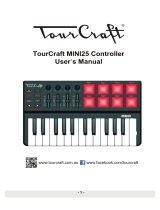
7
The nanoPAD2's Scene parameters
The nanoPAD2’s Scene parameters
Trigger Pad
Depending on the Assign Type setting, these pads can transmit note messages, con-
trol change messages, or program change messages.
Depending on its assign type, up to four note numbers or control change numbers
can be assigned to a single trigger pad and transmitted simultaneously.
If multiple note messages are transmitted from a single trigger pad, they
are all transmitted with the same velocity.
MIDI Channel [1...16/Global]
This specifies the MIDI channel of the MIDI messages that are transmitted when you
strike the trigger pad. If you set this to “Global MIDI Channel,” the messages will be
transmitted on the Global MIDI channel (p.8).
Assign Type [No Assign/Control Change/Note/Program
Change]
This specifies the type of message that will be assigned to the trigger pad.
The Assign Type can be one of the following: disabled, control change message, note
message, or program change message.
Pad Behavior [Momentary/Toggle]
You can choose one of the following two types of behavior for the trigger pad.
Momentary If you’ve assigned a note message, a note-on message will be trans-
mitted when you press the trigger pad, and a note-off message
will be transmitted when you release the trigger pad.
If you’ve assigned a control change message, it will be transmit-
ted with a value of 127 when you press the trigger pad, and with a
value of 0 when you release the trigger pad.
Toggle If you’ve assigned a note message, a note-on or note-off will be
transmitted alternately each time you press the trigger pad.
If you’ve assigned a control change message, it will be transmit-
ted with a value of either 127 or 0, alternating each time you press
the trigger pad.
If you’ve assigned a program change message, the Pad Behavior setting
is ignored; the program change message is always transmitted the in-
stant you press the trigger pad.
Note Number [C-1...G9/No Assign]
This specifies the note number of the note message that is transmitted.
Control Change Number [0...127/No Assign]
This specifies the control change number of the control change message that is transmitted.
Program Change Number [0…127]
This specifies the program change number of the program change message that is transmitted.
Gate Arp Enable [Disable/Enable]
This enables or disables the Gate Arpeggiator.
Trigger pads where this is disabled will be unaffected by the Gate Arpeggiator even if
the Gate Arpeggiator is turned on.
Touch Scale Gate Arp Enable [Disable/Enable]
This specifies whether the Gate Arpeggiator is enabled/disabled when the Touch
Scale mode is “on.”
When the Touch Scale mode is “on,” the Gate Arpeggiator is normally disabled for the
trigger pad. However if the Touch Scale Gate Arp Enable parameter is enabled, the
Gate Arpeggiator will affect the trigger pad even when the Touch Scale mode is “on.”














